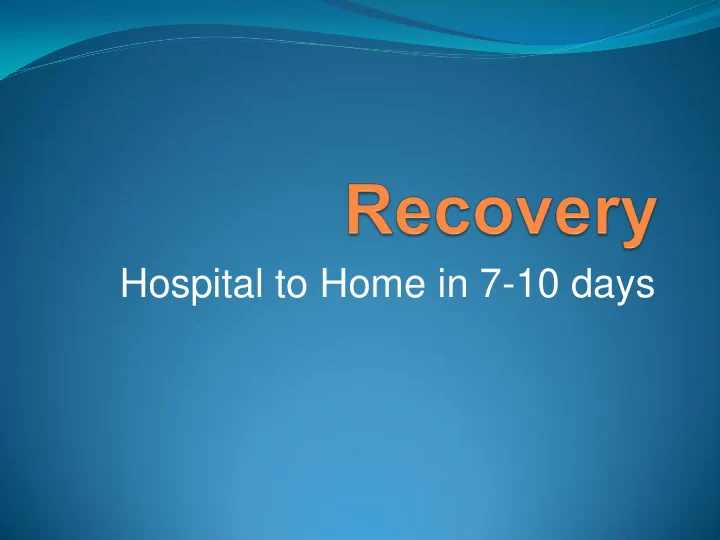

Hospital to Home in 7-10 days
What do we want to achieve? How will we achieve this? Role of the Enhanced Recovery Specialist Nurse. Community Care and Follow Up.
What do we want to achieve?
Enhance the quality of care for this patient group. Support the patient journey pre-operatively, throughout their hospital stay and into the community. Aim to accelerate functional return. Reduce length of hospital stay. Trust objectives: -Safe -Effective -A POSITIVE EXPERIENCE The Newcastle Upon Tyne Hospitals (2015)
To make sure patients are active participants in their own recovery process. Ensuring that patients receive evidence based care at the right time. Preventing readmissions. Achieving productivity gains and cost savings. Paton et al (2014)
How will we achieve this?
One year project which has been funded by Macmillan Cancer Support. Team includes: Enhanced Recovery Specialist Nurse Specialist Dietician Physiotherapy Technical Instructor
Patient at the heart of everything we do!!! Multidisciplinary involvement and commitment of the whole team. Patient involvement/education. Staff involvement/education. Following the Enhanced Recovery After Surgery (ERAS) pathway on a daily basis unless condition dictates otherwise. Pro-active. Enthusiasm/Motivation.
Enhanced Recovery After Surgery Pathway
Role of the Enhanced Recovery Specialist Nurse
Pre-operative care Consultation with Consultant, Specialist Nurse, Enhanced Recovery Specialist Nurse. Patient Information Leaflet - A guide to your Oesophagectomy. Telephone call 5-7 days prior to surgery. Discussion the day before surgery.
Patient Information Leaflet
Pre-operative information If you know what to expect: Pre-operative information Improve confidence and be in and education has been a better frame of mind, shown to improve patient resulting in less anxiety, less satisfaction and allay fear and a reduced ‘stress anxiety. response’ to the operation. Benefits Active participation of the patients themselves in their recovery should be encouraged and daily targets for the patient to achieve should be set up. Royal College of Anaesthetists (2012) Association of Surgeons of Great Britain and Ireland (2009)
Post Operative care Review patient daily - On HDU/ITU or Ward 36. Ensure ERAS pathway is being followed. Liaising with the Multidisciplinary team daily. Patient/Relative education. Staff education. Mobilisation/Physiotherapy exercises. Nutrition. Encourage independence. Reassurance.
Benefits of Enhanced Recovery After Surgery Improved Reduced Improved patient length of patient experience hospital stay satisfaction Reduced Reduced post-operative readmissions Reduced complications after discharge readmissions to critical care NHS Improving Quality (2013)
Enhanced Recovery and QIPP Quality, Innovation, Productivity and Prevention. National, regional and local level programme. Designed to support clinical teams and NHS organisations to improve the quality of care they deliver while making efficiency savings that can be reinvested into the NHS. Department of Health (2010)
Quality - Patients have an improved experience, improved clinical outcome and a reduction in post-operative complications. Innovation - Uses the most up to date techniques. Productivity - Reduction in bed days, reduced length of stay. Preventative - Reduction in post-operative complications, reduces exposure to hospital acquired infections. Department of Health (2010)
Community Care and Follow Up
On Discharge from Hospital Telephone Clinics. Family Support. GP Support. District Nurse. Dietician/Specialist Nurse/Enhanced Recovery Specialist Nurse follow up 2 weeks post discharge. Consultant follow up 6 weeks post discharge.
At Home Tinzaparin administration - 28 days post-operatively. Wound care: Jejunostomy care. Midline and Thorocotomy wounds - clips to be removed if insitu, alternative clips to be removed on day 10 post-operatively, remaining on day 11. Chest drain sutures to be removed when instructed. TED stockings to be worn for 6 weeks.
Driving - 6 weeks after surgery and when comfortable doing an emergency stop. Inform insurance company. Exhausted and low mood - rest and keeping active. Nutrition and hydration - Enteral feed via Jejunostomy tube. Bowels and laxatives. Pain control and pain relief.
Questions???
References Association of surgeons of Great Britain and Ireland (2009) Guidelines for implementation of enhanced recovery protocols. Available at: www.asgbi.org.uk/download.cfm?docid=BE0B52EE-AE0E-42C1. Accessed on: 27 th October 2015. Department of Health (2010) Guide to implementing enhanced recovery. Available at: http://webarchive.nationalarchives.gov.uk/+/www.dh.gov.uk/en/Healthcare/El ectivecare/Enhancedrecovery/index.htm. Accessed on: 27th October 2015. NHS Improving Quality (2013) Enhanced recovery care pathways: a better journey for patients seven days a week and a better deal for the NHS. Available at: www.nhsiq.nhs.uk/download.ashx?mid=8808&nid=8846. Accessed on: 27 th October 2015. Paton, F., Chambers, D., Wilson, P., Eastwood, A., Craig, D., Fox, D., Jayne, D. & McGinnes . (2014) ‘Effectiveness and implementation of enhanced recovery after surgery programmes: a rapid evidence synthesis.
References Royal College of Anaesthetists (2012) Guidelines for patients undergoing surgery as part of an enhanced recovery programme. Available at: https://www.rcoa.ac.uk/system/files/CSQ-ERP-Guide2012.pdf . Accessed on: 26th October 2015. The Newcastle Upon Tyne Hospitals NHS Foundation Trust (2015) Quality Strategy 2015-2018.
Recommend
More recommend